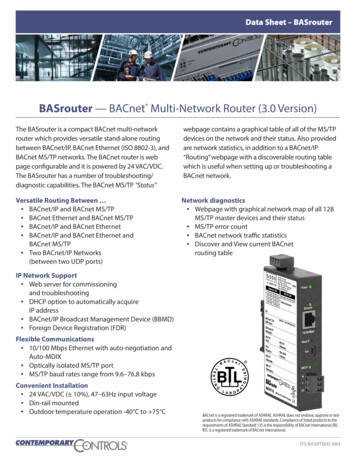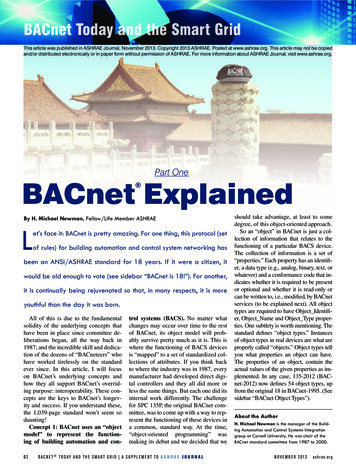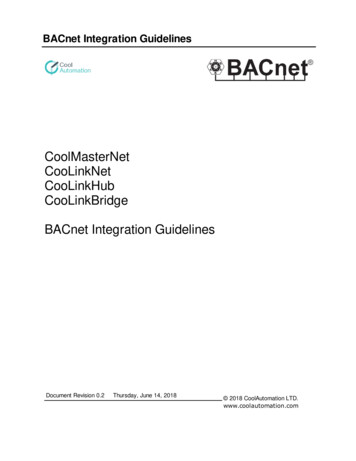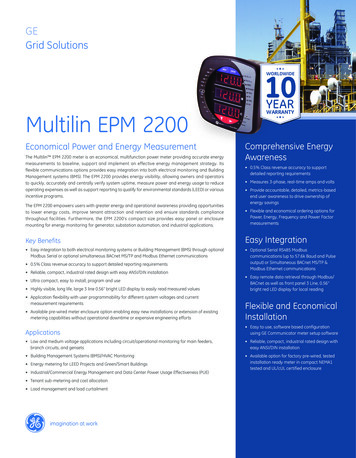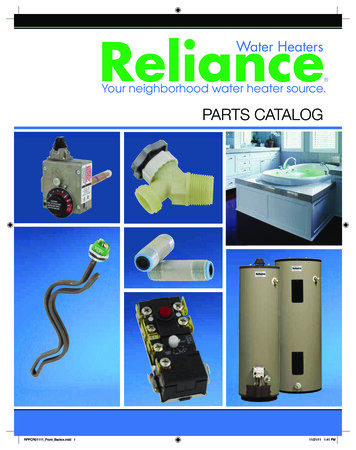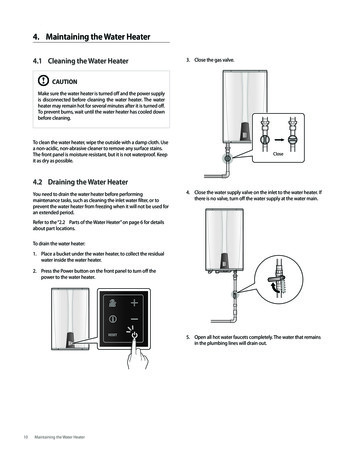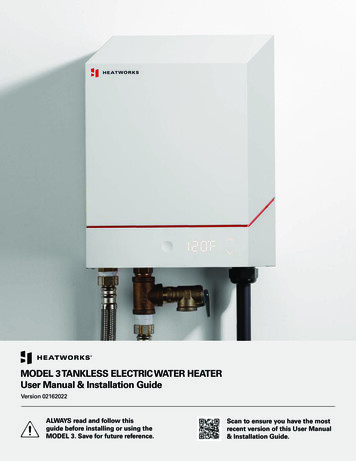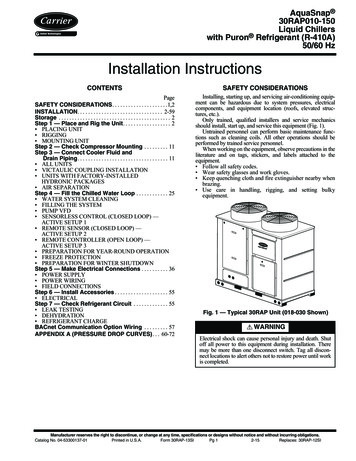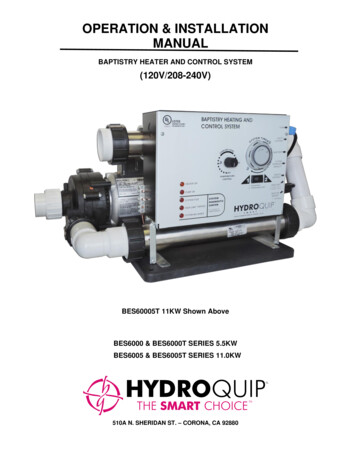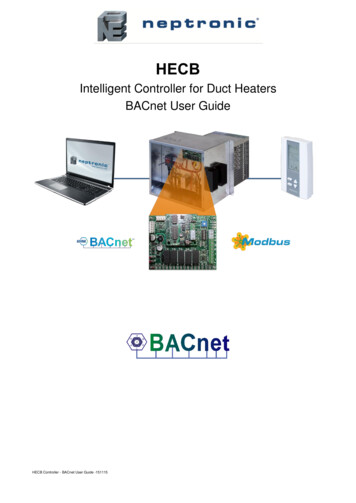
Transcription
HECBIntelligent Controller for Duct HeatersBACnet User GuideHECB Controller - BACnet User Guide -151115
Intelligent Controller for Duct HeatersBACnet User GuideList of TablesTable 1 - BACnet Properties Configuration . 2Table 2 - Device Object Properties . 4Table 3 - Analog Input Object Table . 7Table 4 - Analog Value Object Table . 9Table 5 - Analog and Binary Output Object Table . 13Table 6 - Binary Input Object Table . 13Table 7 - Binary Value Object Table . 14Table 8 - Multi State Value Object Table . 18Table 9 – Factory BACnet Objects . 20UUUUUUUUUUUUUUUUUUContentsIntroduction . 1Pre-requisites . 1Advantages of BACnet . 1BACnet Properties Configuration . 2Configuration Options . 3Quick Setup . 3Manual Setup . 3MAC Address and Max Master. 3Device Object Properties. 4Out of Service Property . 6Object Table Information . 7Analog Input (AI) . 7Analog Value (AV). 9Analog and Binary Output (AO and BO) .13Binary Input (BI) .13Binary Value (BV).14Multi State Value (MSV) .18Program Value (PRG) .19File (File) .19Schedule (SCH) .19Factory BACnet Objects Table .20Notes .26neptronic.compage i
Intelligent Controller for Duct HeatersBACnet User GuideIntroductionThe Intelligent Controller for Duct Heaters (HECB) BACnet Communication Module user guide provides informationabout using the HECB with BACnet communications feature. The BACnet communication protocol for buildingautomation and control networks enables communication between client devices within a network. The HECB controllerprovides a BACnet network interface between BACnet client devices and Neptronic Controller series devices. It usesthe BACnet Master Slave/Token Passing (MS/TP) protocol at the BACnet MAC layer.Pre-requisitesThe BACnet communication user guide assumes that you are familiar with the concepts of BACnet and its terminology.Advantages of BACnetBACnet enabled controllers have the following advantages: Quick Message Transmission. The HECB controller uses a synchronous implementation for BACnet messagesmaking it quick and efficient. Each BACnet confirmed service request is answered as quickly as possible withoutusing the Reply Postponed frame. The MS/TP implementation is performed within Tusage delay of 15 minutesto ensure a Tusage timeout value within 20 minutes. MS/TP Support. The HECB controller supports a Full Master Node state machine for MS/TP. Max Master andthe instances are configured to the device object through BACnet WriteProperty service. The MAC address isset via the DIP switches. Programming mode determines the MS/TP baud rate setting of 9600, 19200, 38400,and 76800. In the configuration mode, the device is configured through the device’s keypad. BIBB Support. The HECB controller functions the same way as the B-ASC type profile server and supports thespecific BIBB as per their relevant S-RP-BoDS-WPM-BoDS-WP-B Object Support. The HECB controller supports a fixed list of BACnet visible values, which appear asPresent Values of various BACnet standard object types in addition to a device object. Alarms. The HECB controller supports indication of various alarm conditions through value changes in propertiesof several objects. However, it does not generate BACnet event notifications.neptronic.compage 1
Intelligent Controller for Duct HeatersBACnet User GuideBACnet Properties ConfigurationTo establish communication on the network, and guarantee a unique ID of devices in a BACnet system, the followingproperties may have to be configured.Table 1 - BACnet Properties ConfigurationPropertyDefault ValueMAC Address000Device InstanceAutoBaud Rate0 AutoConfigurationSet to a value between 000 and 127 via DIP switches. Can also beset to a value between 000 and 254 via menu.The values from 128-254 represent MS/TP non-token passing slavedevices. The controller automatically configures its device instance to153,000 MAC address. The value can be set manually via the menu. The value can be set manually through the WritePropertyservice to Device Object.Object Identifier. The device’s Object Identifier is a combination of the DeviceObject Type (8) and the Device Instance (0-4194302),therefore its decimal or hexadecimal representation tends to beincomprehensible. For example, the Device Instance 1000 has an equivalentObject Identifier of 0x020003E8 hexadecimal or 33555432decimal. The controller configures its baud rate automatically by detectingthe network upon connection. The value can be set manually via the DIP switches from theavailable values of Auto, 9600, 19200, 38400, 76800.Max Master127 Configure Max Master value to increase network efficiency whenthere are less than 127 devices on the network. The Max Master value can be configured through WritePropertyDevice Object.Object Nameneptronic.comName of thedeviceservice to the Device Object.Max Master.For more information, refer to the MAC Address and Max Mastersection. Configure the name of the device through WriteProperty serviceto the Device Object.Object Name. For example, HECB.page 2
Intelligent Controller for Duct HeatersBACnet User GuideConfiguration OptionsThe following options enable you to configure and run the BACnet features of the controllers quickly.Quick SetupConfigure the controller's baud rate and device instance without programming.1.Set a unique MAC address using the DIP switches located on the controller.2.Connect the controller to the network and power it up.3.The controller automatically configures the baud rate and device instance.4.Repeat the steps for each controller.Manual SetupTo use a Device Instance other than 153,000, and /or if your site has more than one controller network, go to thethermostat PGM menu.1.Ensure the thermostat jumper is in the RUN position.2.Press the [*] and [ ] buttons simultaneously for 5 seconds. The “Enter Password” screen appears.3.Enter the 637 password within 1 minute by using the arrow keys to increase or decrease the value andthe [*] and [ ] buttons to toggle between the digits.4.Follow the menus to configure the MAC address, Max Master, Device Instance, and Baud Rate manually.Configure the Max Master value through WriteProperty service to the Device Object.Max Master to increase networkefficiency or if there are less than 127 devices on the network. For more information, refer to the MAC Address andMax Master section.MAC Address and Max MasterThe MAC address must be unique on the entire MS/TP network. However, having a unique MAC address and a highbaud rate does not guarantee efficient operation of the controller and other MS/TP units on the MS/TP network. SomeMAC address and Max Master combinations are more efficient than others. BACnet requires token-passing units tooccasionally “poll” for other masters based on the MAC address and Max Master.A poor combination of MAC addresses and Max Master can lead to a slower network due to lost time polling for mastersthat are not present. Unless there are 126 other units on the MS/TP network, the default Max Master value of 127 is notthe most efficient choice for the controller. The Max Master default value of 127 was selected to ensure that any master,specifically a BACnet client can be found when the controller is initially started.Examples of MAC Address and Max Master ConfigurationsThe following are some of the examples to indicate the optimum combination of MAC address and Max Masterconfigurations to ensure a quick and efficient output.Example 1 MAC 0. Max Master 127 MAC 1, Max Master 127This configuration is slow and inefficient because every time either unit is required to find another master unit, it has topoll 126 units until it finds the right one to pass the token.neptronic.compage 3
Intelligent Controller for Duct HeatersBACnet User GuideExample 2 MAC 0. Max Master 5 MAC 1 to MAC 4 are not used MAC 5, Max Master 5This configuration is better than Example 1 but it is still slower. The Max Master is set to the most efficient value but thegap between the two MAC addresses is high. Therefore, each unit must poll four units until it finds the right one to passthe token.Example 3 MAC 0. Max Master 1 MAC 2, Max Master 2This is an incorrect configuration. The MAC 0 will never find MAC 2 because it will never poll for the master MACaddress 2.Example 4 MAC 0. Max Master 3 MAC 1, Max Master 3 MAC 2, Max Master 3 MAC 3, Max Master 3This is an efficient configuration as the units are numbered consecutively. As a general guideline, the most efficientsetup for an MS/TP network is one in which the units are consecutively numbered starting at MAC address 0 and havingMax Master the maximum MAC address in the system. If consecutive numbering is not possible, then the next mostefficient setup is one in which all units have Max Master the maximum MAC address in the system.Device Object PropertiesThe following table lists all the BACnet properties supported for the device object. The W indicates that the property iswritable using the BACnet WriteProperty service.Table 2 - Device Object PropertiesPropertyValueWritableObject Identifier Programmable where the instance part of the Object Identifier is in the range of 04194302 The device instance must be unique system-wide The default value for the device instance 153000 (Vendor Identifier*1000)WObject Name Programmable up to 32 charactersThe device name must be unique system-wideThe default value is Model NameWDescription Programmable up to 32 charactersThe default value is Intelligent Controller for Duct Heaters.WObject TypeDeviceSystem StatusOperationalVendor IdentifierAlways 153Vendor NameAlways NeptronicModel NameExample, HECB.Firmware Revisioncurrently, V1.xx.xxApplication Software Versioncurrently, 2.03Protocol VersionAlways 1Protocol RevisionAlways 14neptronic.compage 4
Intelligent Controller for Duct HeatersBACnet User GuidePropertyValueWritableMax APDU Length AcceptedCurrently 7, but the value is incremented when an object is created, deleted, or edited andwhen performing a restore.Undefined. This property, of type Unsigned, is a logical revision number for the device'sdatabase. It is incremented when an object is created, an object is deleted, an object's name ischanged, an object's Object Identifier property is changed, or a restore isperformed with the exception that the creation and deletion of temporary configuration filesduring a backup or restore procedure shall not affect this property.Always 480Segmentation Supported(3) No SegmentationAPDU Timeout6,000Number of APDU RetriesAlways 0Local Time00:00:00Local Date01-Jan-2015 (Thu)UTC Offset-3:00Daylight Savings StatusFalseBackup Failure Timeout300Configuration FilesFile-1Last Restore Time2015-01-01 (Thu), 00:01:50:00Backup Preparation Time0Restore Preparation Time0Restore Completion Time0Backup And Restore StateIDLEDataBase RevisionWActive COV SubscriptionProtocol Services SupportedProtocol Object TypesSupportedObject ListDevice Address Binding ControlreinitializeDevice Max Info FramesAlways 1Proprietary property #1000 254 neptronic.comi Ami ansfertimeSynchronizationwho Haswho IsutcTimeSynchronizationsubscribeCOVProperty analog input device analog value file analog output program binary input schedule binary value multi state value binary outputPer the standard. Because of restrictions on the size of the transmit buffers, the entireObject List cannot be returned at once, rather the Object List must be read, one-at-a-time.Depends on number of objects.Always emptyMax MasterProprietary property #1001 Programmable in the range of 0-127Default value 127Read onlyThe proprietary property represents the MS/TP MAC address in the range of 0 toValues from 128 to 254 represent MS/TP non-token passing slave devicesDefault is zeroProgrammable. This proprietary property represents the MS/TP baud rate. This value isUnsigned type, and available values are 9600, 19200, 38400, 76800. Writing 0 will activateauto baud rate functionality. Reading this property will always return actual baud rate. Default :Auto*WWritableonly if DIPswitchMAC 0Notwritable,DIP switchonlypage 5
Intelligent Controller for Duct HeatersBACnet User GuidePropertyProprietary property #1002ValueProgrammable. This proprietary property represents that period of time that an object in/out ofservice will automatically return to normal. Range 0-120 minutes (unsigned type). Writing 0means no automatic return to normal. Default: 15 minutes.WritableWOut of Service PropertyNeptronic controllers offer the use of the Out of Service writable property. When the value of this property is set to True,it disconnects the object from the physical input, enabling you to input other values. This is useful for special applicationsor while troubleshooting. For example, you can ignore the temperature read from a sensor and input the desiredtemperature value in order to perform specific tests.For security reasons, there is a timeout that will set the Out of Service property back to False after 15 minutes. Thisvalue can be modified to between 0 and 120 minutes (For more information, see proprietary property #1002 in Table 2- Device Object Properties).neptronic.compage 6
Intelligent Controller for Duct HeatersBACnet User GuideObject Table InformationThe controller series use the following BACnet object tables, that are categorized based on their IDs. The type is the BACnet Object type, the instance is the BACnet Object.Together, the type and instance form the BACnet Object Identifier for an object according to the following C-language algorithm:object identifier (unsigned long)((unsigned long)type 22) instanceAnalog Input (AI)Table 3 - Analog Input Object TableControl XXXXXXXXXXX1X1X1-40ºF to 212ºF or -40ºC to 100ºCResolution 0.1ºF/0.1ºCX1X1*-40ºF to 212ºF or -40ºC to 100ºCResolution 0.1ºF/0.1ºCX1DischargeTempTemperature measured by the duct sensorconnected to TS5 input of HEC board.Available only if sensor has been pre-configuredat factory or detected on TS5.Out of service*-40ºF to 212ºF or -40ºC to 100ºCResolution 0.1ºF/0.1ºCInletTempTemperature measured by the duct sensorconnected to TS4 input of HEC board.Available only if sensor has been pre-configuredat factory or detected on TS4.Out of service*-40ºF to 212ºF or -40ºC to 100ºCResolution age measured at the analog input.Out of service*AI.2InputTemp/ExternalTempTemperature measured by room sensor or ductsensor.Out of service*AI.3HeaterSensor1TempTemperature measured by EAS heater sensor 1.1 Factory Setting*AI.4HeaterSensor2TempTemperature measured by EAS heater sensor 2.1 Factory Setting*AI.5SSRTempTemperature measured on the solid-state relay.1 Factory SettingAI.6AI.7neptronic.com0 mV to 10000 mV32ºF to 122ºF or 0ºC to 50ºCResolution 0.1ºF/ºC-40ºF to 212ºF or -40ºC to 100ºCResolution 0.1ºF/0.1ºCpage 7
Intelligent Controller for Duct HeatersBACnet User GuideControl e of printed circuit board.Out of service*32.0ºF to 212.0ºF or 0.0ºC to100.0ºC, Resolution 0.1ºF/0.1ºCXXXXXXAI.13TRLTempRoom temperature measured by TRL.2 If TRL is connected.Out of service-40ºF to 392ºF or -40ºC to 200ºCResolution 0.1ºF/ºCX2X2X2X2X2X2AI.14LineFrequencyReading of line frequency.Out of Service*0 to 255 Hz, Resolution 1 HzXXXXXXW?NotesOut of service*57.0ºF to 93.0ºF or 13.9ºC to33.9ºC, Resolution dSetpointNameNetworkAI.8Setpoint value from the control board'spotentiometer.With HECFxxxP models only.Available only when MSV.102 OnBoardSetpoint (1).IDXAdvanced (displayed only if MSV.103 2)AI.200AI TpmDutyTime pulse modulation duty cycle of analog input.Out of Service0 ms to 1000 msAI.201PneumaticPressurePneumatic pressure measured by the externalsensor (input signal).Out of service0.0 PSI to 15.0 PSIAI.202DI TpmDutyTime pulse modulation duty cycle of digital input.Out of Service0 ms to 1000 msXXXXXXX(*): Fixed COV Increment of 0.1 on Temperature values and of 1 on mV and other units.neptronic.compage 8X
Intelligent Controller for Duct HeatersBACnet User GuideAnalog Value (AV)Table 4 - Analog Value Object TableControl atic0.0% to 100.0%, Resolution 0.1%XXXXXX*0 to 1000 millisecsResolution 1msXXXXXXActual heat output in % of full capacity.*0.0% to 100.0%, Resolution 0.1%XXXXXXHeatNominalPowerTheoretic demand in kW.*Range as per designResolution 0.1kWXXXXXXAV.5HeatMeasuredPowerActual measured power in kW using phasetransducers.Available only if current sensing has beenpreconfigured in factory or detected.*Range as per designResolution 0.1kWXXXXXXAV.6HeaterDeltaTemp11 If TRL present andNetwork Setpoint SrcDifference between EAS temperature sensors(AI.3 AI.4). Available only if iEAS are present.*32ºF to 284ºF or 0ºC to 140ºCResolution 0.1ºF/ºCXXXXXXAV.7DuctDeltaTemp11 If TRL present and NetworkSetpoint SrcDifference between Supply and Dischargetemperature sensors (TS4 and TS5).Available only if both TS5 and TS4 are present.*-220ºF to 284ºF or -140ºC to140ºC, Resolution ble maximum system output limit inpercent of total capacity.Present Value0.0% to 100.0%, Resolution 0.1%XXXXXXAV.9UnoccupiedSetpointSetpoint value used during no occupancy.Present Value50ºF to104ºF or 10ºC to 40ºCResolution 0.5ºF/ºCXAV.10VacantSetpointSetpoint used during vacant mode.Present Value50ºF to 104ºF or 10ºC to 40ºCResolution 0.5ºF/ºCXAV.11TRLSetpoint11 If TRL present and NetworkSetpoint SrcSetpoint value from the TRL.Present ValueTRLSetpointMin AV.1SystemDemandActual heating demand.AV.2TPMStageOutputCurrent Time Pulse Modulated stage output dutycycle in percent.AV.3HeatOutputAV.4neptronic.comPresent Value*XXpage 9
Intelligent Controller for Duct HeatersBACnet User GuideControl ModeSetpoint value coming from network BMS.Available only when MSV.100 Internal (2) andMSV.101 NetworkTemp(2).Present Value50ºF to 176ºF or 10ºC to 80ºCResolution 0.5ºF/ºCAV.13InletTempShutdownSetpointThe system turns the unit off when temperatureread by the Inlet Temperature Sensor (TS4) ishigher than the Changeover Setpoint. BV.18must be on.Present Value-40ºF to 212ºF or -40ºC to 100ºCResolution 0.1ºF/0.1ºCAV.14NetworkTempTemperature value coming from network BMS.Available only when MSV.100 Internal (2) andMSV.101 NetworkTemp(2).Present Value32ºF to 122ºF or 0ºC to 50ºCResolution 0.1AV.15NetworkDowncounterCountdown of Network timeout .Out of service0 to 900 secs, Resolution 1 secXAV.16EnergyAuditResultResult of average kWh (see AV.106).*Range as per designResolution DXXXXXXXXXXXX4XXIntegrator - ConfigurationAV.100Cfg ProportionalBandPID controller proportional band value.(P term gain Kp 100/band)Present Value32.9 F to 122ºF or 0.5ºC to 50ºCResolution 0.1ºF/ºCXAV.101Cfg IntegralTimePID controller integral time.(I term gain Ki 1/Ti)Present Value0 (Ki 0) to 300 secsResolution 1 secXAV.102Cfg DifferentialTimePID controller derivative time.(D term gain Kd Td).Present Value0 (Kd 0) to 60 secsResolution 0.1 secXAV.103Cfg TRLSetpointMin33 If set at factoryMinimum programmable setpoint value.Present Value50ºF /10ºC to SetpointMaxResolution 1ºF/ 0.5ºCXXXXXXAV.104Cfg TRLSetpointMax33 If set at factoryMaximum programmable setpoint value.Present ValueSetpointMin to 104ºF / 40ºCResolution 1ºF/ 0.5ºCXXXXXXAV.105Cfg NetworkTimeoutTime without communication from network beforegenerating an alarm and turning the system OFF.If Setpoint and/or Temp sources is Network.2 Temp source Network or TRL and notExternal.Present Value1 to 15 mins, Resolution 1 minXAV.106Cfg EnergyAuditPeriodDefines rolling average used to calculate averagekWh value.Present Value1 to 60 minsXXXXneptronic.comX2XXpage 10
Intelligent Controller for Duct HeatersBACnet User GuideControl aticAV.107Cfg FanOnDelay33 If set at factoryDelay value to turn on the fan in seconds.Present Value1 to 255 secs, Resolution 1 secXXXXXXAV.108Cfg FanOffDelay33 If set at factoryDelay value to turn off the fan in seconds.Present Value1 to 255 secs, Resolution 1 secXXXXXXCfg DuctTempSetpointDuct temperature setpoint. Duct safety BV.106must be ON.BV.106 ON and AI.6 Discharge Temp beavailable.Present Value50ºF to 176ºF or 10ºC to 80ºCResolution 0.1ºF/ºCXXXXXXCfg DuctTempCutoutDuct temperature cutout. Duct safety BV.106must be ON.BV.106 ON and AI.6 Discharge Temp beavailable.Present Value122ºF to 194ºF or 50ºC to 90ºCResolution 0.1ºF/ºCXXXXXXCfg DuctTempPropBandPID controller proportional band value for ducttemperature. (P term gain Kp 100/band). Doesnot appear if Auto PID BV.107 is ON. Availableonly if BV.106 ON, AI.6 Discharge Tempavailable and BV.107 OFF.Present Value32.9 F to 122ºF or 0.5ºC to 50ºCResolution 0.1ºF/ºCXXXXXXCfg DuctTempIntegralTimePID controller integral time for duct temperature.(I term gain Ki 1/Ti). Does not appear if AutoPID BV.107 is ON. Available only if BV.106 ON,AI.6 Discharge Temp available and BV.107 OFF.Present Value0 (Ki 0) to 720 secsResolution 1 secXXXXXXAV.305Cfg DuctTempDerivativeTimePID controller derivative time for ducttemperature. (D term gain Kd Td). Does notappear if Auto PID BV.107 is ON.Available only if BV.106 ON, AI.6 DischargeTemp available and BV.107 OFF.Present Value0 (Kd 0) to 10 secsResolution 0.1 secXXXXXXAV.306Cfg PowerAlarmThresholdThe % error between the nominal (AV.4) andmeasured (AV.5) power.Present value5 to 25%, Resolution 1%XXXXXXAV.307Cfg StageOnDelayDelay value to turn on a stage in seconds.Present Value1 to 255 secs, Resolution 1 secXXXXXXAV.308Cfg StageOffDelayDelay value to turn off a stage in seconds.Present Value1 to 255 secs, Resolution 1 secXXXXXXIDNameDescriptionW?NotesAdvanced - Configuration (displayed only if MSV.103 2)AV.301AV.302AV.303AV.304neptronic.compage 11
Intelligent Controller for Duct HeatersBACnet User GuideControl riptionExternalNameNetworkIDAV.309Cfg PneumaticSignalMinPneumatic signal minimum value.Present Value0 to Cfg PneumaticSignalMaxResolution1 millivoltXAV.310Cfg PneumaticSignalMaxPneumatic signal maximum value.Present ValueCfg PneumaticSignalMin to10,000, Resolution1 millivoltXAV.311Cfg InputTempOffsetInput temperature offset calibration. Only if AI.2is available.Present Value 10.0ºC, Resolution 0.1ºCXXXXXXAV.312Cfg HeaterSensor1TempOffsetHeater sensor 1(EAS) temperature offsetcalibration. Only if AI.3 is available.Present Value 10.0ºC, Resolution 0.1ºCXXXXXXAV.313Cfg HeaterSensor2TempOffsetHeater sensor 3(EAS) temperature offsetcalibration. Only if AI.4 is available.Present Value 10.0ºC, Resolution 0.1ºCXXXXXXAV.314Cfg SSR TempOffsetSSR temperature offset calibration. Only if AI.5 isavailable.Present Value 10.0ºC, Resolution 0.1ºCXXXXXXAV.315Cfg DischargeTempOffsetDischarge sensor (TS5) temperature offsetcalibration. Only if AI.6 DischargeTemp.Present Value 10.0ºC, Resolution 0.1ºCXXXXXXAV.316Cfg SupplyTempOffsetSupply sensor (TS4) temperature offsetcalibration.Present Value 10.0ºC, Resolution 0.1ºCXXXXXXAV.317Cfg BoardTempOffsetPCB temperature offset calibration.Present Value 10.0ºC, Resolution 0.1ºCXXXXXXAV.318Cfg TRLTempOffsetTRL thermostat internal temperature offsetcalibration. Only if AI.10 TRLTemp is available.Present Value 10.0ºC, Resolution 0.1ºCXXXXXX(*): Fixed COV Increment of 0.1 on Temperature values and of 1 on mV and other units.neptronic.compage 12
Intelligent Controller for Duct HeatersBACnet User GuideAnalog and Binary Output (AO and BO)Table 5 - Analog and Binary Output Object TableControl aticAO.1FeedbackVoltageVoltage output read at pin 7.Present Value*0 to 10,560 mV, Resolution 1mVXXXXXXBO.1FanOutputFan output status. If fan is available (factory).Present ValueOut of service0 Off, 1 OnXXXXXXIDNameDescriptionW?Notes(*): Fixed COV Increment of 0.1 on Temperature values and of 1 on mV and other units.Binary Input (BI)Table 6 - Binary Input Object TableControl aticBI.1ThermalCutoutStatus is On when Thermal Input opened.-0 Open, 1 CloseXXXXXXBI.2AirflowCutoutStatus is On when no air flow(AirFlowInput opened).-0 Open, 1 CloseXXXXXXBI.3InterlockCutoutStatus is On when Interlock Input opened.-0 Open, 1 ge 13
Intelligent Controller for Duct HeatersBACnet User GuideBinary Value (BV)Table 7 - Binary Value Object TableControl criptionNetworkNameID0 Heat, 1 OffXXXXXX-0 Off, 1 OnXXXXXX-0 Off, 1 OnXXXXXX-0 Off, 1 OnXXXXXX-0 Off, 1 OnXXXXXX-0 Off, 1 OnXXXXXX-0 Off, 1 OnXXXXXX-0 Off, 1 OnXXXXXX-0 Off, 1 OnXXXXXX-0 Off, 1 ual system mode.Status of stage 1 output.Number of stages depends on internalconfiguration.Status of stage 2 output.Number of stages depends on internalconfiguration.Status of stage 3 output.Number of stages depends on inte
Intelligent Controller for Duct Heaters BACnet User Guide neptronic.com page i List of Tables UTable 1 - BACnet Properties Configuration U. 2 UTable 2 - Device Object Properties U .
